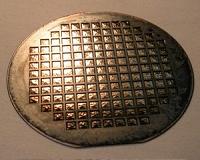 |
Hannover, Germany (SPX) Apr 06, 2011 In the future, the growing amounts of solar and wind energy will need to be stored for dark or low-wind periods. One solution is redox flow batteries that can supply current for up to 2000 households. Several Fraunhofer Institutes are working jointly on these fluid batteries of the future. The researchers will present their large battery installation at the Hannover Messe. Green power is an unstable commodity. Photovoltaic plants rest at night, and wind turbines stand still when there are lulls in the wind. This is why in the future there will be a need for intermediate storage of considerable amounts of environmentally friendly power. One of the hot topics at the moment is the use of electric cars for intermediate power storage. Experts agree that this alone will not suffice. Instead, large-scale stationary storage facilities will be needed, substations centrally located in the grid and capable of buffering energy in megawatt quantities for low-current periods. A Fraunhofer consortium is currently driving the development of large-scale energy-storage systems known as redox flow batteries. The experts' long-term goal is to build a handball-court-sized battery installation with a capacity of 20 MWh - enough energy to provide power to roughly 2000 households through a long winter's night or a cloudy day. The results have not advanced quite so far: At the moment, the largest laboratory facilities at the Fraunhofer Institute for Environmental, Safety and Energy Technology UMSICHT have an output of several kW. At the Hanover Fair (Hannover Messe), the researchers will demonstrate the operation of the redox flow battery using a 2-kW plant. Three Fraunhofer institutes are involved in the consortium working to expedite the development of these storage batteries. "The process already works reliably," notes Dr. Christian Dotsch, business unit manager for Energy Efficiency Technologies at UMSICHT, one of the participating institutes. "The challenge lies in the upscale version, the enlargement of these plants." Redox flow batteries are large-scale vanadium-based liquid batteries in which chemical vanadium bonds alternately pick up and emit electrons along membranes. Because these batteries use only vanadium bonds and not two different fluids at the same time as found in other systems, impurities are eliminated. "This makes it possible to build very robust and durable batteries - a decisive advantage of this battery technology," emphasizes Dr. Tom Smolinka, in charge of coordinating the work at the Fraunhofer Institute for Solar Energy Systems ISE. The vanadium charges and discharges in tiny reaction chambers. Several of these chambers are arrayed in stacks to increase a battery installation's output even further. Currently, the membranes - and hence the individual cells - have a surface area roughly equal to that of a DIN A4 sheet of office paper. "To achieve megawatt values, we need to reach a size of at least DIN A0 (ca. 85 x 120 cm)," estimates Dr. Jens Tubke, division director at the third project partner, the Fraunhofer Institute for Chemical Technology ICT. One of the challenges is to insure that the vanadium fluid flows smoothly through these large membranes and past the felt-like carbon electrodes in the cells themselves. To accomplish this, Fraunhofer researchers are therefore using flow simulations to further improve the design of the cells. Since last year, the Fraunhofer consortium has also been working on new membrane materials and battery designs in a cooperation project funded by the German federal ministry for the environment. Another project is scheduled to begin this year and will involve industry participation. On principle, batteries with up to 80 kW of storage capacity can be built in the new Fraunhofer redox flow laboratory - and a 20-kW plant is scheduled to go into operation at the end of next year. The researchers hope to cross the megawatt threshold in roughly five years.
Share This Article With Planet Earth
Related Links Fraunhofer-Gesellschaft Powering The World in the 21st Century at Energy-Daily.com
 The First Macro-Scale Thin-Film Solid-Oxide Fuel Cell
The First Macro-Scale Thin-Film Solid-Oxide Fuel CellCambridge MA (SPX) Apr 06, 2011 Materials scientists at the Harvard School of Engineering and Applied Sciences (SEAS) and SiEnergy Systems LLC have demonstrated the first macro-scale thin-film solid-oxide fuel cell (SOFC). While SOFCs have previously worked at the micro-scale, this is the first time any research group has overcome the structural challenges of scaling the technology up to a practical size with a proportio ... read more |
|
| The content herein, unless otherwise known to be public domain, are Copyright 1995-2010 - SpaceDaily. AFP and UPI Wire Stories are copyright Agence France-Presse and United Press International. ESA Portal Reports are copyright European Space Agency. All NASA sourced material is public domain. Additional copyrights may apply in whole or part to other bona fide parties. Advertising does not imply endorsement,agreement or approval of any opinions, statements or information provided by SpaceDaily on any Web page published or hosted by SpaceDaily. Privacy Statement |